Corporate Law IBA 2025 Final
1/137
There's no tags or description
Looks like no tags are added yet.
Name | Mastery | Learn | Test | Matching | Spaced |
|---|
No study sessions yet.
138 Terms
Public Law / Common Law
It is about the relationship between the state and its citizens.
Government involvement is key
Constitutional, administrative, and criminal law
Characteristic: You do not depend on legal books but more on judgement. It is about the legal verdicts of courts (shareholder oriented)
Private / Civil law
Rights and duties of natural persons towards each other
The government is typically not a party
Contract, tort, property, trusts, family
Characteristics: Primary source of the law is the law books. We still have verdicts that can also determine the determination of legal rights
Tort
It is a civil wrong, other than breach of contract, that causes a claimant to suffer loss or harm, resulting in legal liability for the person who commits the tortious act
Corporations
Legal forces where you can effectively organize your business activities.
It is a legal entity with limited liability
Most commonly used business form for larger economic activities
Closed / Private Corporations
Not traded on stock exchange, limited number of shareholders, less regulation
E.g., family businesses
Open / Public Corporations
Listed on stock exchange, many shareholders, stricter regulations, raises capital trough stock sales, such as Tesla and Apple
Main Actors Corperations
Shareholders, employees, the corporate board / directors, and creditors
Creditors
Have a priority claim so are paid first in case of bankruptcy.
No voting rights
Fix claim
General Partnership
Structure where two or more people co-own a business.
Unlimited liability
Everyone has the same authority
Limited Partnership
Partnership with at least one general partner and one or more limited partners.
General partners have unlimited liability,
Limited partners have limited liability
Limited Liability Partnership
All partners have limited liability
All partners can be involved in management
Limited Liability Limited Partnership
Has general and limited partners
Both have limited liability
Sole proprietorship
One person is responsible for all aspects of the business
Unlimited liability, so responsible for all debts and liabilities
Has full control over the business
Businesses are not taxed separately
Minimal regulation
Jurisdiction (US)
Legal authority that a specific country, state, or court has over a business entity
Federal government: Governs national laws and regulations
State governments: Handle laws specific to each state, including corporate law
Federal Court
Handles cases related to federal matters such as patents, securities, or interstate lawsuits, such as disputes that cross state lines
State Court
Handles most legal matters, such as corporate law, contracts, and business disputes
Example DGCL
Many multinational corporations are incorporated in Delaware due to its corporation-friendly policies and favorable tax policies
Example Sarbanes-Oxley Act
Federal US law that protects investors from fraudulent accounting activities by corporations
EU Regulation
A binding legislative act. It must be applied in its entirety across the EU. Most are useful and strict, as they bind the legal subjects
EU Directives
Set out a goal that all EU countries must achieve. However, it is up to the member states to devise their laws and how to reach these goals. Difference between minimum and maximum harmonisation
Minimum Harmonisation
The EU sets a basic standard that all member states must follow, but they are free to introduce stricter national rules if necessary. This allows each member state to adopt the directive to its own situation
Maximum Harmonisation
The EU sets a standard but leaves no room for stricter or flexible national rules. It fully harmonizes a particular area of law, and thus all MS must follow exactly the same rules
EU Recommendations
Not binding. A recommendation allows the institutions to make their views known and to suggest a line of action without imposing any legal obligation on those to whom it is addressed
Hard Law
Legally binding regulations, such as corporate laws and security laws (traffic lights)
Soft Law
Non-binding guidelines, principles, or best practices that companies are encouraged to follow but are not legally required to
Corporate governance code
A soft law. Sets of principles that outline the best practices for companies in areas such as transparency and shareholder rights
Many corporate governance codes operate under a flexible approach where companies can:
Comply: With the governance rules
Explain: Why they do not follow the rules
This allows businesses to adopt best practices to their specific needs
Incorporation
The formation of a company. Different documents need to be filed, including the Articles of Association. To be legally recognized, companies must be incorporated according to specific jurisdictional requirements
Articles of Association
The Articles of Association are a legal document that outlines the rules and regulations for the internal management and operation of a company. They serve as a contract between the company and its shareholders, directors, and officers.
It consists of:
Mandatory rules: Cannot be modified by contract. Usually aim to protect weaker parties (creditors)
Default rules: Applicable in case articles of association or another contract do not state otherwise
Basic legal characteristics
Legal personality
Limited liability
Transferability of shares
Delegated management under a board structure
Investor ownership (sometimes state ownership)
Legal Personality
Treats a company like a person, meaning it can own property, sign contracts, and act separately from its shareholders.
However, since it’s not a real person, it needs someone to represent it and make decisions on its behalf
Entity Shielding
Because of legal personality, the company is the owner of the assets, and shield these from the shareholders
Liquidation Protection
The shareholders cannot withdraw the company’s assets at will, preserving the company’s ongoing value
Priority Rule
Ensure that the company’s creditors have the first claim on the corporation’s assets for any company debts before shareholders can claim any residual value
Separate Patrimony
Legal concept where a person or entity has a distinct pool of assets and liabilities that are legally separated from their personal or other business assets
Limited Liability
Shareholders are only liable up to their committed investment
Owner shielding
Shields the shareholders from the liabilities of the company
Advantages of limited liability
Effective capital markets; without limited liability, you wouldn’t invest in companies
Without it, there wouldn’t be any start-ups in the first place
Reduces the need for shareholders to monitor every step and facilitates the diversification strategies used by investors
Asset Partitioning
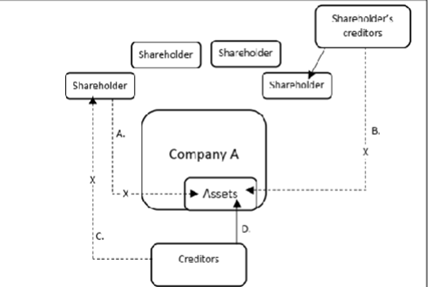
Assets of the corporation are separated from those of the shareholders
Tort victims
Creditors that become creditors unintentionally
Become creditors when there is a lawsuit and the judge grants them a claim
Cannot negotiate ex ante about the terms of their claims, and thus risk cannot be translated into better protection
Judgement Proof Problem
Occurs when companies limit their liability by structuring assets in a way that reduces what creditors can claim.
If a subsidary has low assets, creditors may not get full compensation, even if the corporate group as a whole is wealthy
Corporate Sustainability Due Diligence Directive (CSDDD)
A proposed EU law aimed at making companies responsible for their environmental and human rights impact throughout their supply chains. It requires large companies operating in the EU to identify, prevent, and address negative effects on people and the planet caused by their business activities.
Transferable Shares
Really crucial for a company’s continuity when ownership changes
Enhance the liquidity of shareholder investments because they make it easier for shareholders to maintain diversified portolios
Authorized Capital
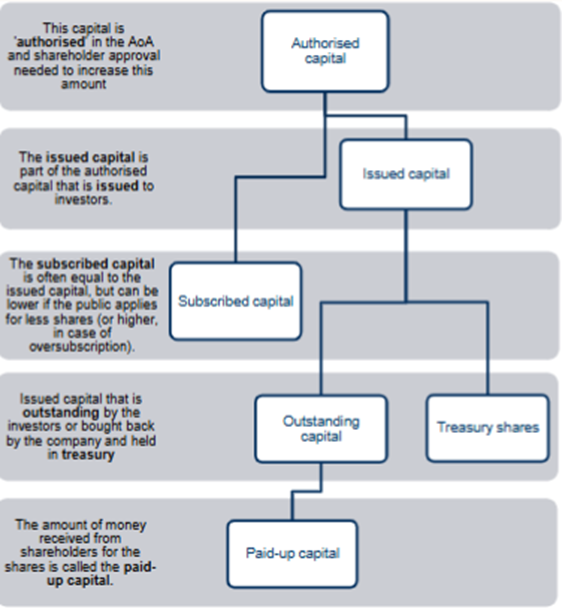
The maximum share capital that the company is allowed to issue which is stated in the articles of association. If it wants to increase this number, it needs to get approval of the existing shareholders
Issued Capital
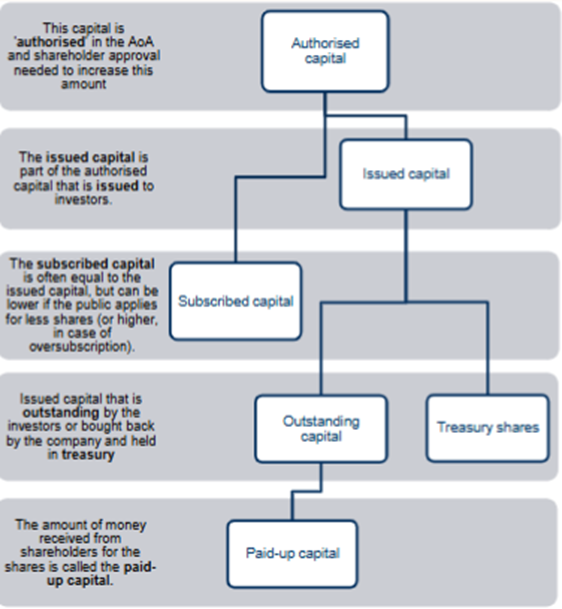
Part of the authorised capital that is issued to investors
Treasury shares
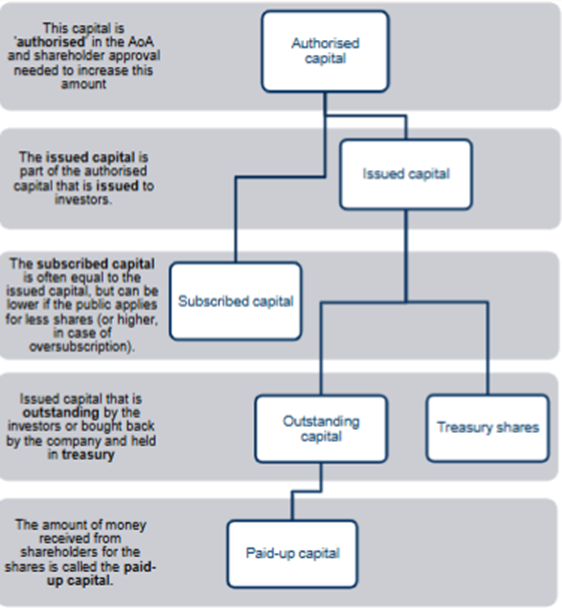
Issued capital that is bought back by the company and held in treasury
Paid-up Capital
The amount of money actually received from shareholders for the shares
In-kind contributions
Shares can also be issued for non-monetary contributions, these need to be assessed
European minimum capital rule
Minimum capital is 25,000 euros according to the European Capital Directive, but member states may set higher amounts
Main arguments against minimum capital requirements
Does not provide meaningful protection for creditors
The assets that are bought with the share capital can decline in value, whereas the legal capital stays fixed
There is no actual relationship between the minimum capital and the business activities or funding needs of a public company
The same requirement for both small and large firms
The liabilities of any company are well beyond this minimum capital requirement
Creditors can be better protected in other ways
The minimum capital may increase the costs of starting a public company, which may limit entrepreneurship and innovation
Delegated Management under a board structure
Principal authority over corporate affairs: generally elected by shareholders
This structure allows a company to operate efficiently by centralizing decision-making authority within a corporate board
Capital rights
Financial rights:
Dividends
Sale of shares
Control rights
Decision-making rights:
Essential rights for shareholders to influence corporate governance
Vote
Question the board
Certain information rights
Manager-Shareholder conflict
Managers have more information and potentially different interests than shareholders, leading to decisions that may not always align with what shareholders want
Different interests include FCF problems, risk appetite, different time horizons, and on-the-job consumption
The Majority-Minority Shareholder Conflict
In firms with controlling shareholders, majority owners may make decisions that benefit themselves at the expense of minority shareholders
Self-dealing transactions, excessive executive pay, or strategic dilution of minority stakes
Legal solutions include disclosure requirements, independent board oversight, and judicial review of related-party transactions
The Shareholder-Creditor Conflict
Shareholders may pursue riskier projects to maximize returns, knowing that creditors bear much of the downside risk
Firms may issue excessive debt, prioritize dividend payments over loan obligations, or take on high-risk ventures without regard for creditor interests
Protective legal mechanisms include capital maintenance rules, creditor rights in bankruptcy, and financial disclosure regulations
Legal Strategies
Mitigate the vulnerability of principals to the opportunism of their agents
Regulatory strategies: Agent constraining = Focus in US
Governance strategies: Principal empowering = Focus in Europe
Appointment Rights and Decision Rights
Selection and Removal / Initiation and Veto: Shareholder appointment rights, decision-making rights, and shareholder and management proposals
Exit rights
Investors and creditors can sell shares, trigger covenants, or seek legal remedies if corporate governance failures become evident
Unitary Boards
Common in the US and UK
A single board oversees management
Executive and non-executive directors together in one board
Two-Tier Boards
Seperates board members into two seperate boards
Supervisory board: Elected by the shareholders, in the German model also by employees. They oversee the management board
Managing board: Similar to the executive board members in the one-tier board model. Responsible for the company’s day to day operations
Options for shareholders to share their dissatisfaction with the management
They can sell their shares and thus exit the company
They can use their voting rights and other decision-making rights to influence the corporate governance of the company directly
Fundamental decisions for shareholders
Appointment rights: Appoint board members who are in charge of strategic decision-making
Decision rights: Voting on M&A, changes to the corporate charter, and changes to Articles of Association
Management proposals (veto/ratification): The board suggests these to the AGM, where shareholders can vote on these proposals
Shareholder proposals
Annual General Meeting (AGM)
A formal decision-making body where shareholders use their voting rights. Shareholders can individually or collectively make decisions that are legally valid and shape the direction of the company
Appointment Rights
It’s a ratification right. The board usually nominates its own candidates, and shareholders can then approve or disapprove of these at the AGM
It includes the removal of shareholder-appointed directors, which can only be removed by shareholders, usually without a valid cause and at any time
Decision-making rights
Increasing the share capital
Waiver of pre-emption rights
Repurchase of shares
Nachgründung
These four are related to share capital and mostly belong to shareholders in Europe. In the US the board of directors is mostly in charge of these
Amending articles of association (charter amendments)
Large transactions, mergers, and demergers
Related to external auditor
Annual financial statements
Dividends
Say on Pay
RPT (related-party transaction)
Discharge
Amending articles of association
Always need a shareholder vote to change articles of association
In most countries a quality majority is needed, a higher majority than simply 50% (e.g., 2/3). Exceptions are Delaware and The Netherlands
Discharge
Very common in continental Europe. Is the declaration or the statement of shareholders to not hold their board members liable for everything they disclosed to them in a certain financial year
Pre-emption rights
Allow existing shareholders to be the first to buy new shares that will be issued by the company. Mandatory in Europe, shareholders from the US do not possess these rights
Nachgründung
A right that involves transactions with founders or major shareholders. The shareholders have the right to approve or disapprove these transactions within a certain timeframe
Rule 14a-8 of the Exchange Act
Allows shareholders to make shareholder proposals, which the corporate board must include in the proxy statements
Proxy Statements
The invitations that include the information about the shareholder meeting
Resubmission thresholds
Ensures that a proposal that gets repeatedly rejected must gain increasing support over time to be reconsidered
Proxy fights / contests
The party seeking to gain control over the company through the corporate board proposes its own board members for election at the shareholder meeting.
For this, an own proxy campaign needs to be started.
Can be considered a takeover strategy
3 of the 13 grounds of exclusion of Rule 14a-8
The nomination of a specific individual in the company’s proxy materials for election to the board of directors
A proposal that deals with a matter relating to ordinary day-to-day business operations
A shareholder proposal that micromanages the company: If it is too prescriptive, limiting the discretionary powers of the board of directors
Proxy access
The shareholder right to include its own nominees with the company’s proxy materials without having to circulate their own proxy materials
Contral Enhancing Mechanisms
Mechanisms that allow shareholders with minimal stake to have majority control (i.e., controlling minority). Pyramid Structure and Dual-Class Firms
Pyramid Structure
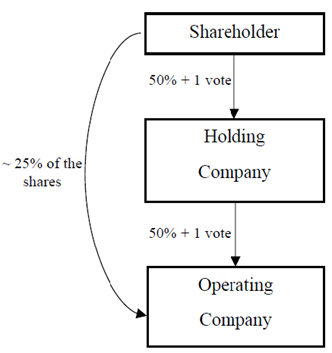
Controlling minority shareholders that holds a controlling stake in a holding company that, in turn, holds a controlling stake in an operating company
Private Benefits of Control (PBC)
The gain resulting from exercising control for controlling shareholders at the expense of noncontrolling shareholders
Tunneling
The transfer of resources out of a company to its controlling shareholder
At the expense of minority shareholders
Blockholders can use the firm’s funds for their own gains
Cumulative Voting

With cumulative voting, votes are collected for all directors that can be elected, and shareholders can distribute their votes in any manner they choose
Cumulative voting example:
100 votes in total
A has 60 votes
B has 40 votes
3 Directors up for election
So A has 180 votes in total and B 120 votes
A can choose 2 directors and B can choose 1
Slate voting
A slate is a group of candidates that run in multi-seat or multi-position elections on a common platform (all are members of a political party or have the same policies)
Trusteeship Strategy: Independent Directors
Originated in the US
Seeks to remove conflicts of interests ex ante
Do not profit from opportunistic behaviour
Not tied by financial incentives but motivated by ethical and reputational concerns
Criticism against the trusteeship strategy of independent directors
Arbitrary criteria
No conclusive evidence of the effect on firm performance
Their role during the financial crisis has been criticised
Shareholders are the owners of the company. True or False
True, but it depends on what you call ownership. They have capital and control rights. It is different than the type of ownership you have of an object
The Dodd-Frank Act
Granted the SEC the power to make rules facilitating the inclusion of shareholder nominations in the corporate proxy materials. Leading to the SEC adopting rule 14a-11
Rule 14a-11
The Rule holds that a shareholder (or shareholders jointly) holding 3% of the voting share capital for 3 years can include its own nominees with the company’s proxy materials
In 2011, the D.C. Circuit ruled against this rule. But shareholders may still file shareholder proposals seeking proxy access, which are non-binding
Full structured regime: special structure in The Netherlands
Used for all types as long as the following criteria are met for 3 consecutive years
Capital and earnings amount to 16 million euros
Legal obligation to appoint a work council
At least 100 employees in the Netherlands
Weakened structured regime: special structure in The Netherlands
Apply to companies of which at least half of the issued capital is held by a legal entity whose majority of employees work outside the Netherlands
Types of directors
One-tier board
Executive directors
Non-executive directors
Non-executive directors (grey directors): Representatives of major shareholders or employees, former executives
Non-executive independent directors: No relationship with the company other than board membership
Two-tier board
Independent supervisory board members
The Companies Act (Belgium)
A director in a listed company is to be considered independent if she does not maintain a relationship with the company or with a major shareholder that jeopardizes her independence
Corporate Governance Code (Germany)
The Supervisory Board shall include what it considers to be an appropriate number of independent members from the group of shareholder representatives. Independent if they are independent from the company’s Management board and of any controlling shareholder
Listing Rules of a Stock Exchange (Nasdaq)
Majority Independent Board: A majority of the board of directors must be comprised of Independent Directors
Co-determination in Germany
More than 2000 employees
Half of supervisory board = employee representatives
Chairman (usually shareholder representative)
500-2000 employees
One third of supervisory board = employee representatives
Board of directors: gender diversity
Germany: Supervisory board shall be composed of atleast 30% men and 30% women
France: Atleast 40% of both genders in stock exchange-listed companies
Which form, one-tier or two-tier, is preferable? Usual Arguments:
The one-tier board structure results in a closer relation and better information flow between the supervisory and managerial directors
The two-tier board structure encompasses a clearer, formal seperation between the supervisory body and those being supervised
Convergence between one-tier and two-tier boards
One-tier boards make use of delegation to the management and monitoring the exercise of delegated powers becomes their main task
Both board structures depend on management information
The use of independency requirements for the non-executive/supervisory board members, making them more separated
Tasks and board committees, including a nomination committee
The board of directors: other committees
CSR and Sustainability Committee
Audit Committee
Nomination & Compensation Committee
Corporate Management Committee
Securityholders Relationship Committee
Independent Directors Committee
Role of the board
Running the company
Monitoring (non-executives, supervisory board): Overseeing day-to-day operations
Executing the strategy (executives, management board): Day-to-day operaionts
Execute duties described by the company law & not doing what is forbidden by the law
Representing the company
Board Duties
Constraint Strategy —> Legal constraints:
Duty of Care
Duty of Loyalty
The constraints strategy
A regulatory strategy that limits the board members in their behavior to restrict shareholder-manager agency problems